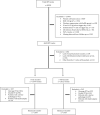Impact of elective frozen vs. fresh embryo transfer strategies on cumulative live birth: Do deleterious effects still exist in normal & hyper responders?
- PMID: 32589634
- PMCID: PMC7319321
- DOI: 10.1371/journal.pone.0234481
Impact of elective frozen vs. fresh embryo transfer strategies on cumulative live birth: Do deleterious effects still exist in normal & hyper responders?
Abstract
Background: Is freeze-all strategy effective in terms of cumulative live birth rates (CLBRs) in all patients?
Methods: This retrospective single-center study analyzed the CLBRs of 2523 patients undergoing fresh or electively frozen blastocyst transfer cycles. In 1047, cycles, the fresh embryo transfer (ET) strategy was applied for the 1st ET, whereas electively frozen ET (e-FET) was performed in 1476 cycles. Female age ≤ 37 and blastocysts frozen via vitrification were included. The patients in each arm were further stratified into four subgroups according to the number of oocytes retrieved as follows: Group A: 1-5, group B: 6-10, group C: 11-15 and group D: 16-25 oocytes retrieved. The primary endpoint was the CLBR. The secondary endpoints were the ovarian hyperstimulation syndrome (OHSS) rate and the live birth rates (LBRs) following fresh ETs and e-FETs for the first transfers.
Result(s): The CLBR was similar between the fresh ET and e-FET arms in group A (35/76 (46.1%) vs 29/67 (43.3%), p = 0.74) and group B (165/275 (60%) vs 216/324 (66.7%), p = 0.091), whereas significantly higher rates were detected in favor of the e-FET arm within group C (328/460 (71.3%) vs 201/348 (57.8%), p<0.001) and group D (227/348 (65.2%), vs 446/625 (71.5%), p<0.001). The OHSS rate was also found to be higher in the fresh ET arm among group C (12/348 (3.4%) vs 0/460 (0%), p<0.001) and group D (38/348 (10.9%) vs 3/625 (0.5%), p<0.001) patients than e-FET arm. Perinatal and obstetrical outcomes were nonsignificantly different between fresh and e-FET arms. However, the birth weights were significantly lower for fresh ET, 3064 versus 3201 g for singletons (p<0.001).
Conclusion: Compared with a fresh-transfer strategy, the e-FET strategy resulted in a higher CLBR among patients with >10 oocytes retrieved during stimulated cycles.
Conflict of interest statement
Authors FKB, NET, MG, SE, NF and MB are employees of Bahceci Health Group. ZY is an employee of Cyprus Science University. There are no patents, products in development, or marketed products associated with this research to declare. This does not alter our adherence to PLOS ONE policies on sharing data and materials.
References
Publication types
MeSH terms
Associated data
LinkOut - more resources
Full Text Sources


